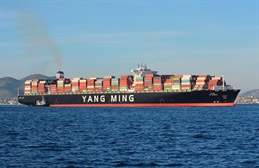
Yang Ming Marine Transport Corp. said it will prioritize reliable service delivery, agile capacity management, and expansion into new markets as it navigates a persistent supply–demand imbalance in global container shipping.
The company is also advancing a fleet optimization program — including orders for three 8,000 TEU methanol dual‑fuel‑ready containerships — to boost operational flexibility and support its low‑carbon transition.
The Taiwan-headquartered carrier posted Q2 2025 revenues of US $1.21 billion and a net profit of US $30.9 million amid softer freight rates and trade uncertainty.
Yang Ming reported consolidated revenue of US$2.64 billion and after-tax net profit of US$274.82 million for the first half of 2025. The carrier's earnings per share stood at NT$2.51, pressured by weaker cargo volume and rate levels stemming from ongoing trade negotiation uncertainties, as well as the recognition of Profit-Seeking Enterprise Income Tax on undistributed earnings.
The July 2025 IMF World Economic Outlook lifted its global GDP growth projections to 3.0% for 2025 and 3.1% for 2026, suggesting trade barriers have had less impact than expected. However, Yang Ming pointed out that "uncertainties in trade talks and geopolitical developments continue to cloud the outlook."
In container shipping, it cited Drewry and Alphaliner's forecast that global fleet capacity to expand by 6.3% and 6.2%, respectively, in 2025, far outpacing demand growth estimates of 2.0% and 2.7%, underscoring a persistent supply–demand imbalance. Drewry also expects softer conditions in the second half, following a surge of front‑loaded shipments earlier in the year.
Meanwhile, Yang Ming noted that trade lane performance remains uneven. Transpacific volumes have been dampened by U.S. tariff uncertainty, while Asia–Europe and Asia–Mediterranean routes are projected to stay positive. Intra‑Asia demand is stable, but markets such as Asia–Australia and Asia–Latin America warrant close monitoring for volatility.
"Looking ahead, Yang Ming will focus on reliable service delivery, agile capacity management, and new market development to navigate market fluctuations," the carrier said.
"The Company will continue advancing its fleet optimization program, replacing older vessels with energy-efficient, alternative fuel–ready tonnage, strengthening operational flexibility, and building a low-carbon, sustainable, and safe global transportation network," Yang Ming added.



